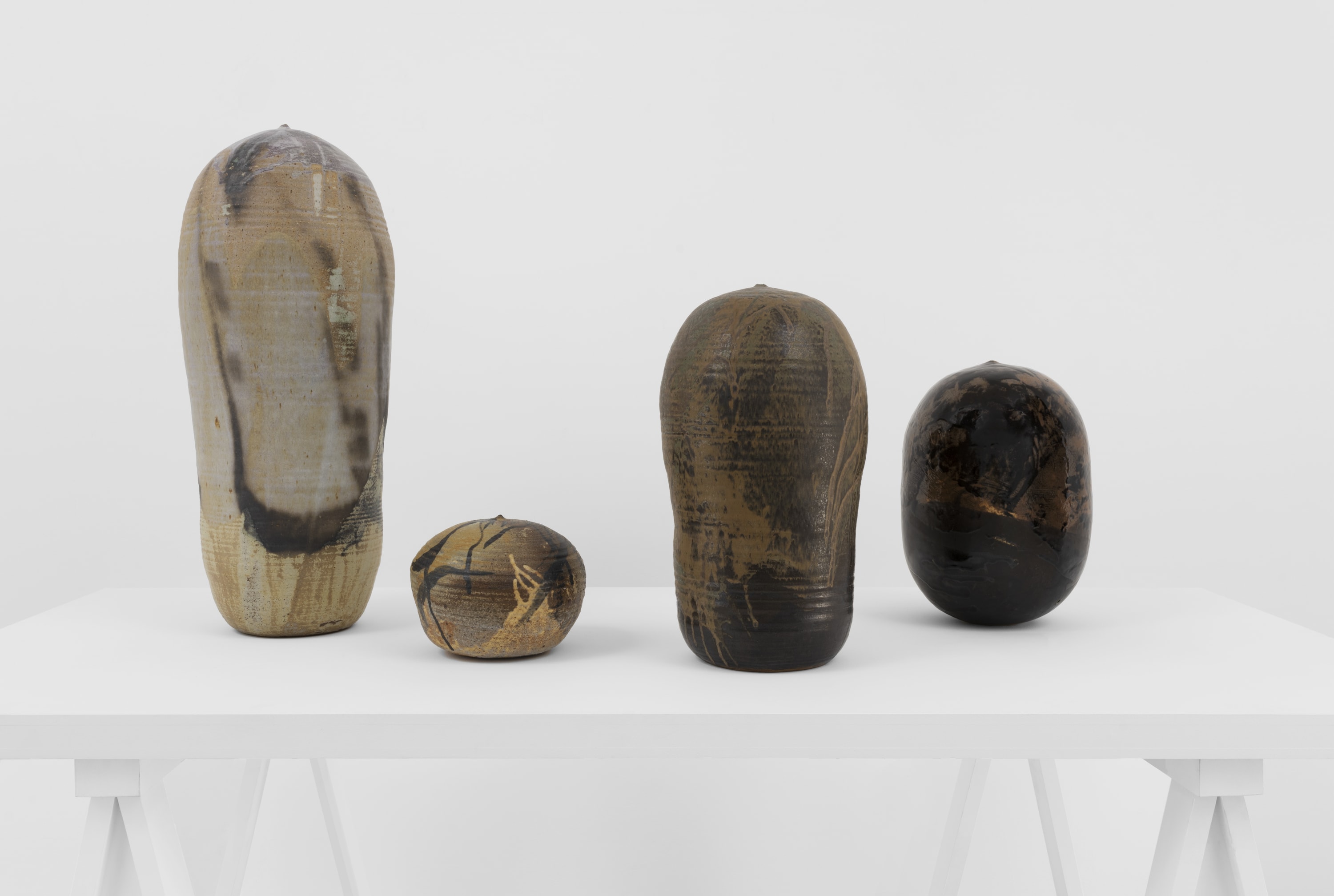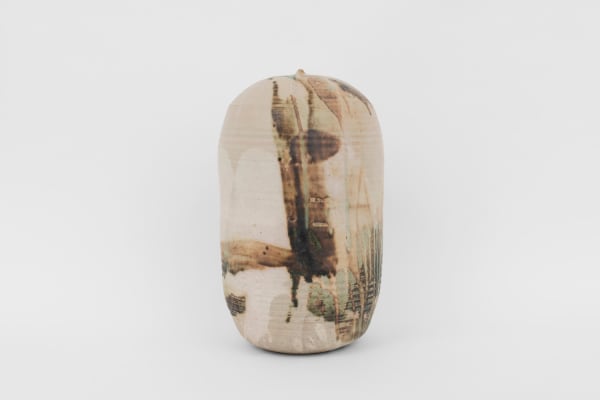-
James Cohan is pleased to present a selection of sculptures by the American master ceramicist Toshiko Takaezu from an important private collection. Takaezu (b. 1922, Pepeekeo, Hawaii - d. 2011, Honolulu, Hawaii) had a prolific career that spanned five decades. Her aesthetic approach was influenced by Abstract Expressionism and the traditions of East Asia, including ink painting and the Japanese tea ceremony. Her signature closed forms fuse these visual inspirations and demonstrate the artist’s process of abstraction, in which she experimented with gestural application of glazes, treating the vessel as a canvas in the round.
Takaezu’s work will be featured in the 2022 edition of the Venice Biennale as part of Cecilia Alemani’s exhibition, The Milk of Dreams.
-

-
“Takaezu is a painter in glaze, a sculptor in clay, and a ceramist who honors many traditions, while following her own voice.”
- Bruce W. Pepich
-
Takaezu began working towards the closed form in the 1950s, experimenting with a wide range of multipart vessels, as well as pieces with narrow openings that she called “mask pots.” Once she fully enclosed the interior volume – leaving a small opening that allowed for gas to escape during firing, a sort of vestigial spout – she had a format that allowed her to explore a wide range of effects: layering, veiling, and expressionist gesture. The act of closure rendered the vessels functionless, suggesting that they now inhabited the realm of sculpture, as well as pottery. She continued to produce these forms well into the 1990s and 2000s, eventually at monumental scale. This exhibition features sculptures as small as 4 inches and taller forms nearing 28 inches high.
-

Takaezu throwing a closed form. Photographer unknown - Toshiko Takaezu Archives. Courtesy of The Family of Toshiko Takaezu.
-
Takaezu experimented widely with applications of glaze on the surfaces of her closed forms, drawing influence both from Abstract Expressionism and Asian calligraphic technique. She applied glaze onto the clay with a brush while also occasionally, in a controlled manner, dipping and pouring glaze to create dynamic surfaces. Each work is a 360 degree painting, meant to be experienced at different angles and never all at once. Her palette often references colors seen in nature – particularly her home state of Hawaii – like ochre, black, white, brown and soft grays and varying shades of blue. Applications of yellow, pink, orange and greens were often atmospheric and sometimes suggestive of landscapes through their layering.
-
Striking blue hues figure prominently in Takaezu’s oeuvre. She drew inspiration from her native Hawaii - where it would appear to her in the ocean, fish, shells and flowers. This small form, made around 1960, is a classic representation of her use of blue glaze.
-

-
Takaezu evolved a discrete series of globular forms that she called Moons. From the early 70s on, these were formed from two halves in molds. Their surfaces may be smooth, shiny, or matte, often featuring a multitude of colored glazes. Takaezu sometimes departed from the spherical, as with Untitled (1990s),a three-quarter moon featuring delicate washes of white, greenish gray and yellow ochre glaze swooping over its curved surface. Her moons recall heavenly bodies and planetary forms.
-

Takaezu with her Moons : Photo Credit by Hiro. Courtesy of The Family of Toshiko Takaezu.
-

-
Untitled is a closed form that was not thrown on the wheel but hand-built. She was never particularly concerned with symmetry and this piece is an example of the artist embracing irregularity, even accentuating it with stripes of dark glaze.
-

-

-

-
“One of the best things about clay is that I can be completely free and honest with it. And clay responds to me. The clay is alive and responsive to every touch and feeling. When I make it into a form, it is alive, and even when it’s dry, it is still breathing! I can feel the response in my hands, and I don’t have to force the clay. The whole process is an interplay between the clay and myself, and often the clay has much to say.” - Toshiko Takaezu
-

Toshiko throwing a closed form at the Penland School of Crafts, North Carolina. Photo credit: Evon Streetman. Courtesy of The Family of Toshiko Takaezu.
-
Throughout the artist’s lifetime, her work was exhibited widely in the United States and Japan, including a solo exhibition at the Philadelphia Museum of Art (2004) and a retrospective at the National Museum of Modern Art in Kyoto, Japan (1995). Takaezu was the recipient of a McInerny Foundation Grant (1952), Tiffany Foundation Grant (1964), National Endowment for the Arts Fellowship (1980), among others. Takaezu received honorary doctorate degrees from Lewis and Clark College (1987), Moore College of Art and Design (1992), University of Hawaii (1993), Princeton University (1996), and Skidmore College (2004). Her work is represented in collections including the Art Institute of Chicago, DeYoung/Fine Arts Museum of San Francisco, Honolulu Museum of Art, Los Angeles County Museum of Art, The Metropolitan Museum of Art, New York, Museum of Fine Arts, Boston, and the Smithsonian American Art Museum. Her work is included in the 2022 edition of the Venice Biennale, The Milk of Dreams curated by Cecilia Alemani. Takaezu passed away in Honolulu on March 9, 2011.
-
Checklist
-
 TOSHIKO TAKAEZU, Untitled, ca. 1990s
TOSHIKO TAKAEZU, Untitled, ca. 1990s -
 TOSHIKO TAKAEZU, Untitled, ca. 1990s
TOSHIKO TAKAEZU, Untitled, ca. 1990s -
 TOSHIKO TAKAEZU, Untitled, ca. 1990s
TOSHIKO TAKAEZU, Untitled, ca. 1990s -
 TOSHIKO TAKAEZU, Untitled, ca. 1990s
TOSHIKO TAKAEZU, Untitled, ca. 1990s
-
 TOSHIKO TAKAEZU, Untitled, ca. 1990s
TOSHIKO TAKAEZU, Untitled, ca. 1990s -
 TOSHIKO TAKAEZU, Untitled, ca. 1990s
TOSHIKO TAKAEZU, Untitled, ca. 1990s -
 TOSHIKO TAKAEZU, Untitled, ca 1960
TOSHIKO TAKAEZU, Untitled, ca 1960 -
 TOSHIKO TAKAEZU, Untitled, ca. 1990s
TOSHIKO TAKAEZU, Untitled, ca. 1990s
-
 TOSHIKO TAKAEZU, Untitled, ca. 1990s
TOSHIKO TAKAEZU, Untitled, ca. 1990s -
 TOSHIKO TAKAEZU, Untitled (3/4 Moon), ca. 1990s
TOSHIKO TAKAEZU, Untitled (3/4 Moon), ca. 1990s -
 TOSHIKO TAKAEZU, Untitled, ca. 1990s
TOSHIKO TAKAEZU, Untitled, ca. 1990s -
 TOSHIKO TAKAEZU, Untitled, ca. 1990s
TOSHIKO TAKAEZU, Untitled, ca. 1990s
-
-
SOURCES:
Bruce W. Pepich, “Toshiko Takaezu: An Essential Balance”, October 13 - November 25, 2000, published by Perimeter Gallery, Chicago, 2000.
John Perreault, “Toshiko Takaezu: Truth In Clay,” from Toshiko Takaezu: Heaven and Earth published on the occasion of the exhibition of her multipart installation Star Series, at the Racine Art Museum, Racine, Wisconsin, from September 2005 - January 8, 2006.
Peter Held, “In the language of silence, The Art of Toshiko Takaezu” 2010, published by The Toshiko Takaezu Foundation, New York.
Genji Amino and Christina Hobbs, “No Monument: In the Wake of the Japanese American Incarceration,” Published on the occasion of the exhibition at the Noguchi Museum, March 16 - May 15, 2022.
Toshiko Takaezu Foundation - https://www.toshikotakaezufoundation.org
Special thanks to Donald Fletcher, Glenn Adamson and the Family of Toshiko Takaezu.
Toshiko Takaezu
Past viewing_room



























